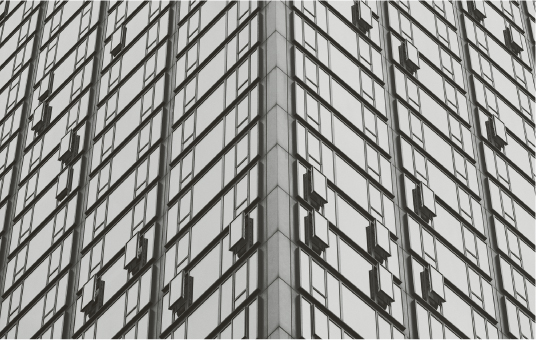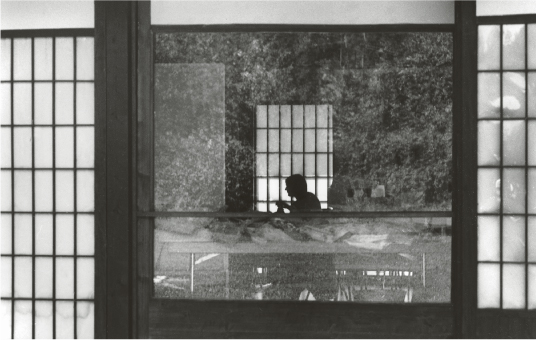19 Rhythm—Recurring Elements
Like in music, pictures can be characterized by a certain rhythm. When you include rhythm in a photo, it is important to make the pictorial content abstract and to master the language of shapes.
In fact, the concept of rhythm comes from music, because one thinks of the bars that create the rhythm, but rhythm generally implies something like the constant repetition of similar things, such as for example, the seasons. However, recurrence of does not refer only to time; the space in an image can also be structured by rhythm. If in music rhythm is the basic structure of how time is divided, then rhythm in an image is the basic structure of how a space is divided by the elements.
The four photos presented in this chapter gain their strength of design from their pictorial rhythms; their compositions are simple and they have very few elements. Yet it is precisely the repetition of these few elements that gives these photos their power. Some modern musical pieces (techno, for example) also gain their strength from the constant repetition of a basic musical form. Some African drumbeats are repeated over and over again in ritual ceremonies to generate a trance in the listener. Naturally, with such constant repetition, whether in music or images, contrast can prevent monotony.
Arches, Lines, and Rhombi
In the photo in figure 19–1, the vertical window structures provide the main pictorial rhythm. The arches of the bicycle stands in the lower-right corner continue with a variation of this rhythm, and a third rhythm is provided by the rhombi and triangles of the Western Harbor Tower. A man in the middle of these shapes walks by, and his black and white clothes also fit into the composition. The man, in turn, is the antithesis to the excessively rigid linear forms in the photo. He has been photographed in the best possible instant because he has just emerged from the shadow but is still far enough from the image border. He is exactly in the middle of the Western Harbor Tower. Without this man, the architectural forms by themselves would make the photo look too rigid; he is the essential final touch.
In such a photo it is good to set up the composition and then to have enough patience to wait for the right person to walk by to shoot at precisely the right moment.
The photo was taken digitally using a 160 mm focal length. (You can recognize the telephoto lens perspective by the lines that get only slightly smaller.) The image was converted to black and white using the Photoshop yellow filter preset in the Black & White adjustment tool, and medium-tone contrast was increased a little with the Shadow/Highlight tool. While I was taking the photo, it was important to check that both the white shirt of the man and the bright window elements still had some texture. Before the actual shooting, it is a good idea to shoot one photo as an exposure test.

Rhythm of Window Lines
The photo in figure 19–2 of Berlin’s Potsdam Square also has a minimal composition, with the rhythm being provided by the repeated window sections, which taper off toward the top. If you compare this pictorial composition with a musical piece, you can find parallels: Bolero by Ravel is one such piece in which the same basic structure is played throughout, from a quiet beginning to a loud, dramatic ending. The same rhythm applies to the minimal images seen in figures 19–1 and 19–2. The same element is repeated in almost identical form; in this photo, the distances between the lines become gradually greater toward the bottom. However, the antithesis to the rhythm of the lines is also indispensable here in the form of the young man. Without him, the photo would be dead formalism, a rigid linear structure. But, here a unity of man and space has been created in a cool, down-to-earth atmosphere. Nevertheless, the image is powerful owing to the absolutely minimal rhythmic composition.
The photo was taken with an analog Nikon F4 and a 105 mm lens on Ilford Delta 100.

Minimalist Structure
If the intention is to let a photo stand out solely due to its minimal graphic structure, it is essential to ensure that this graphic structure does not look sterile. The photo of Frankfurt’s Maintower (figure 19–3) has a simple composition: The corner of the skyscraper runs exactly along the vertical axis of symmetry. From this corner, the horizontal lines of the building extend to the left and right, providing folding symmetry. The constant repetition of these lines is what gives the image its rhythm, but it would still be sterile if this rhythm were not broken by individual accents. The windows, opened in various places by coincidence, resemble a melody that is being played according to the basic rhythm. This melody is by all means necessary to make the photo interesting.
The difficulty in this photo was to check how Maintower looked with various focal lengths and to find out in what spot and with what focal length the opened windows would play the most interesting melody on this basic rhythm. In this case, it was the 235 mm focal length of Canon’s zoom lens. As in most digital photos, contrast was increased by about 20 percent.

The Place of the Conference—Japanese Style
Translucent rectangles directly bordering on each other generate the pictorial rhythm in the photo in figure 19–4. Such window elements are often found in Japanese architecture, influenced by the teachings of Zen Buddhism.
Once again, the person in the center of the image provides the needed antithesis to the austerity of the architectural forms. As opposed to the photo of Maintower, organic forms are reflected in the windows and mix with the architecture in an interesting way. It was important here not to place the person in the dead center but to shift the focal point a little to the right. By doing this, additional tension was created between the larger area dominated by rectangles on the left side and the smaller area on the right side.
The photo was taken with an analog camera and the 105 mm telephoto lens of a Nikon F4.

